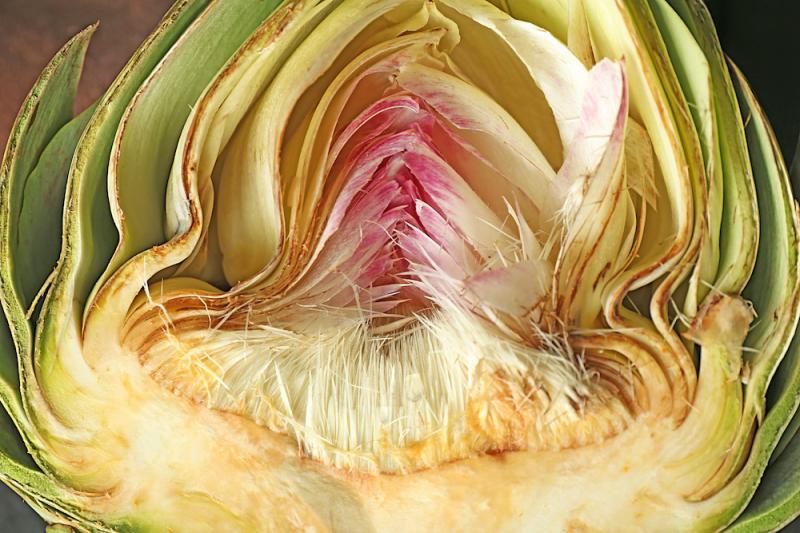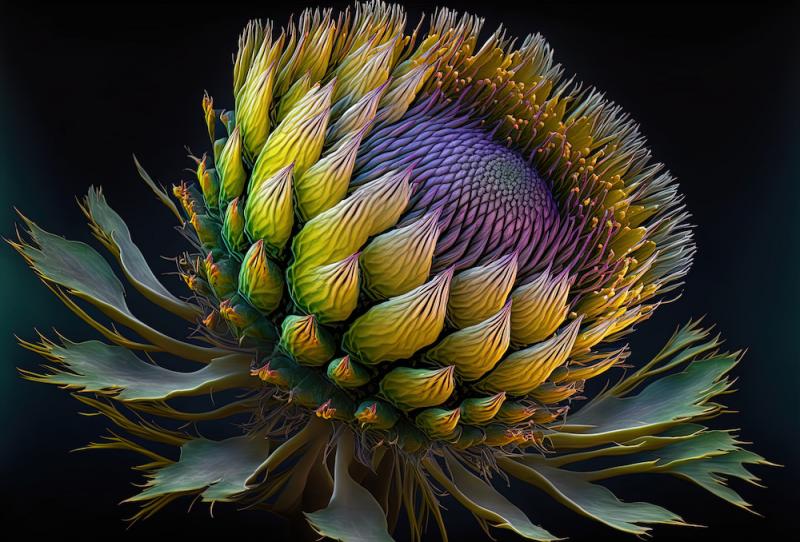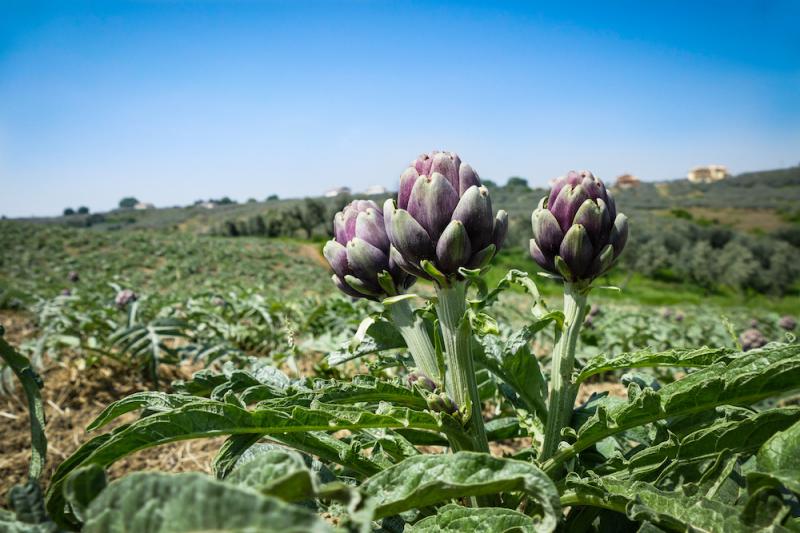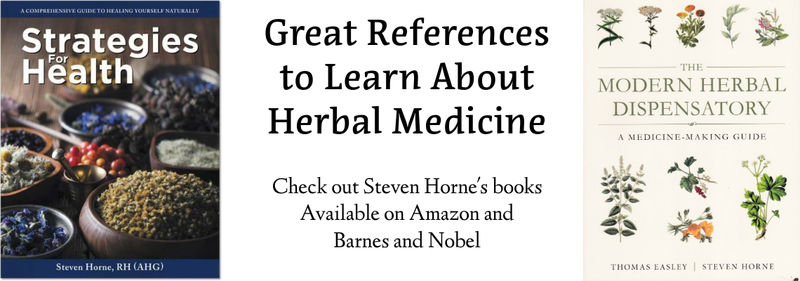
Artichokes belong to the largest family of flowering plants, now known as the Asteraceae or Aster family, which is also known as the daisy or sunflower family. It’s also the family for many popular medicinal herbs and ornamental plants, including dandelions, chicory, echinacea, black-eyed Susan’s, and more.
When I studied botany in college it was known as the Compositae or Composite family. And, it’s the name I still prefer because I think it’s a better description of the family.
Botanical Structure
 When you eat an artichoke, unlike most vegetables, you're eating the flower head that was harvested before it bloomed. Artichokes are a great example to see the structure of Composite family flower heads. At the bottom is the base or receptacle. That’s known as the artichoke heart and is the most desirable part to eat. The part you’re buying when you get canned or bottled artichoke hearts. Surrounding the heart are the green brackets, which enclose the flower head. You can eat the base part of the brackets, too, but that requires some patience as each bracket contains only a small fleshy part.
When you eat an artichoke, unlike most vegetables, you're eating the flower head that was harvested before it bloomed. Artichokes are a great example to see the structure of Composite family flower heads. At the bottom is the base or receptacle. That’s known as the artichoke heart and is the most desirable part to eat. The part you’re buying when you get canned or bottled artichoke hearts. Surrounding the heart are the green brackets, which enclose the flower head. You can eat the base part of the brackets, too, but that requires some patience as each bracket contains only a small fleshy part.
The white fibrous structures in the middle are the immature disk flowers. Disk flowers are tiny flowers that bloom at the center of a daisy or sunflower. The tiny blue fiber-like structures in the picture of the blooming flower below are the disk flowers of the artichoke.
Although the artichoke doesn’t have them, what we think of as the petals of a daisy or sunflower are actually individual ray flowers. Artichokes and the thistles they are closely related to only have disk flowers, while plants like the dandelion and salsify only have ray flowers.
Digestive Bitter
 Artichoke leaves have as many of the health benefits associated with thistles. For starters, they are a simple bitter that can be used as a cholagogue and digestive stimulant in digestive bitters, something discussed in the article on gentian. They stimulate the production of stomach acid and are a particularly good cholagogue for stimulating bile flow. Thus, artichoke can help digest fats and proteins and is helpful for dyspepsia, IBS with alternating diarrhea and constipation, poor appetite, gas and bloating, and constipation.
Artichoke leaves have as many of the health benefits associated with thistles. For starters, they are a simple bitter that can be used as a cholagogue and digestive stimulant in digestive bitters, something discussed in the article on gentian. They stimulate the production of stomach acid and are a particularly good cholagogue for stimulating bile flow. Thus, artichoke can help digest fats and proteins and is helpful for dyspepsia, IBS with alternating diarrhea and constipation, poor appetite, gas and bloating, and constipation.
Cholesterol Reducer
As a cholagogue, they’re also useful for reducing LDL cholesterol. Most of the cholesterol in your body doesn’t come from your diet. It’s made by the liver, which uses LDL cholesterol to transport fatty acids from the liver to the tissues, and HDL to transport fat-soluble substances back to the liver. If you increase bile flow and have sufficient fiber in the intestines to bind it so it’s removed from the body, you can lower cholesterol just by using cholagogues like artichoke and fiber like psyllium, oat bran, or even seaweeds. It also contains flavonoids that may help to inhibit cholesterol synthesis.
Liver Protective Herb
 Artichoke also has direct benefits to the liver because it has hepatoprotective qualities, so it can help the liver safely detoxify chemicals. It contains cyanin, cynarine, and cyanoside, all of which increase bile flow, assist liver regeneration, and have antibacterial activity. It also has liver-protective capabilities. Thus, it can also be helpful for jaundice and a congested and sluggish liver.
Artichoke also has direct benefits to the liver because it has hepatoprotective qualities, so it can help the liver safely detoxify chemicals. It contains cyanin, cynarine, and cyanoside, all of which increase bile flow, assist liver regeneration, and have antibacterial activity. It also has liver-protective capabilities. Thus, it can also be helpful for jaundice and a congested and sluggish liver.
If you’ve never eaten an artichoke. I'd encourage you to try them. To cook them, steam them until the base is soft. To eat them peel off the brackets and dip them in a little melted butter and lemon juice, scraping off the soft green base of the brackets with your teeth. At a certain point, there’s no longer enough flesh to make eating them worthwhile. At that point remove the rest of the brackets and the white immature flowers and eat the heart; it’s delicious and probably has a lot of the same health benefits as the leaves.
And, by the way, the heads of many thistles are edible in the same way, except they’re so small that the hearts don’t give you much, which is a lot of work for just a small bite.
Downloads
Steven's Articles
-

-
Understanding Caffeine & Cellular Adaptation
Preserving the power of caffeine's buzz and the…
September
-

-
Horseradish
A pungent spice for aiding protein metabolism…
-

-
Banaba or Crepe Myrtle
A beautiful tree from Southeast Asia whose leaves…
August
-

-
Monkeyflowers
Flower essences to help see ourselves more clearly…
-

-
Mariposa Lilies
Strengthening the bond between mother and child…
-

-
The Noble Bay Leaf
A common kitchen herb for aiding digestion and…
-

-
Epimedium: Horny Goat Weed
A circulatory stimulant and kidney yang tonic…
July
-

-
The Medicinal and Nutritional Benefits of Apricots
A nutritious fruit and valuable medicinal seed for coughs
-

-
Dogwoods
Asian dogwood is used to stop excessive discharge,…
June
-

-
Neem: The Village Pharmacy
A popular Ayurvedic remedy for dental and immune…
-

-
Spilanthes: The Toothache Plant
A traditional remedy for teeth and gums, as well…
-

-
Forsythia
An anti-inflammatory, fever-reducing, and infection fighting herb
May
-

-
Buckwheat (Kashi)
A delicious, high protein, gluten-free, gut-healthy food
-

-
Leaky Gut Syndrome
Plugging the leaks on the underlying cause of…
-

-
Storksbill
An edible, medicinal, weedy herb, helpful for…

